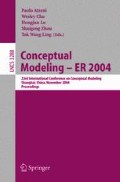Abstract
Despite the existence of well-known software sizing methods such as Function Point method, many developers still continue to use ad-hoc methods or so called “expert” approaches. This is mainly due to the fact that the existing methods require much implementation information that is difficult to identify or estimate in the early stage of a software project. The accuracy of ad-hoc and “expert” methods also has much problem. The entity-relationship (ER) model is widely used in conceptual modeling (requirements analysis) for data-intensive systems. From our observation, the characteristic of a data-intensive system, and therefore the source code of its software, is well characterized by the ER diagram that models its data. Based on this observation, this paper proposes a method for building software size model from extended ER diagram through the use of regression models. We have collected some real data from the industry to do a preliminary validation of the proposed method. The result of the validation is very encouraging. As software sizing is an important key to software cost estimation and therefore vital to the industry for managing their software projects, we hope that the research and industry communities can further validate the proposed method.
Access this chapter
Tax calculation will be finalised at checkout
Purchases are for personal use only
Preview
Unable to display preview. Download preview PDF.
References
Albrecht, A.J., Gaffney Jr., J.E.: Software function, source lines of code, and development effort prediction: a software science validation. IEEE Trans. Software Eng. SE-9(6), 639–648 (1983)
Armour, P.: Ten unmyths of project estimation: reconsidering some commonly accepted project management practices. Comm. ACM 45(11), 15–18 (2002)
Boehm, B.W., Fairley, R.E.: Software estimation perspectives. IEEE Software, 22–26 (November/December 2000)
Boehm, B.W., et al.: Software Cost Estimation with COCOMO II. Prentice Hall, Englewood Cliffs (2000)
Chen, P.P.: The entity-relationship model - towards a unified view of data. ACM Trans. Database Syst. 1(1), 9–36 (1976)
Conte, S.D., Dunsmore, H.E., Shen, V.Y.: Software Engineering Metrics and Models, Benjamin/Cummings (1986)
COSMIC-Full Functions – Release 2.0 (September 1999)
Dolado, J.J.: A validation of the component-based method for software size estimation. IEEE Trans. Software Eng. SE-26(10), 1006–1021 (2000)
Ferens, D.V.: Software Size Estimation Techniques. In: Proceedings of the IEEE NAECON, pp. 701–705 (1988)
Garmus, D., Herron, D.: Function Point Analysis: measurement practices for successful software projects. Addison-Wesley, Reading (2000)
Kemerer, C.F.: An empirical validation of software project cost estimation models. Comm. ACM 30(5), 416–429 (1987)
Lai, R., Huang, S.J.: A model for estimating the size of a formal communication protocol application and its implementation. IEEE Trans. Software Eng. 29(1), 46–62 (2003)
Laranjeira, L.A.: Software Size Estimation of Object-Oriented Systems. IEEE Trans. Software Eng. 16(5), 510–522 (1990)
McClave, J.T., Sincich, T.: Statistics, 9th edn. Prentice Hall, Englewood Cliffs (2003)
Miranda, E.: An evaluation of the paired comparisons method for software sizing. In: Proc. Int. Conf. On Software Eng., pp. 597–604 (2000)
Neter, J., Kutner, M.H., Nachtsheim, C.J., Wasserman, W.: Applied Linear Regression Models. In: IRWIN (1996)
Teorey, T.J., Yang, D., Fry, J.P.: A logical design methodology for relational databases using the extended entity-relationship model. ACM Computing Surveys 18(2), 197–222 (1986)
Verner, J., Tate, G.: A software size model. IEEE Trans. Software Eng. SE-18(4), 265–278 (1992)
Author information
Authors and Affiliations
Editor information
Editors and Affiliations
Rights and permissions
Copyright information
© 2004 Springer-Verlag Berlin Heidelberg
About this paper
Cite this paper
Tan, H.B.K., Zhao, Y. (2004). ER-Based Software Sizing for Data-Intensive Systems. In: Atzeni, P., Chu, W., Lu, H., Zhou, S., Ling, TW. (eds) Conceptual Modeling – ER 2004. ER 2004. Lecture Notes in Computer Science, vol 3288. Springer, Berlin, Heidelberg. https://doi.org/10.1007/978-3-540-30464-7_15
Download citation
DOI: https://doi.org/10.1007/978-3-540-30464-7_15
Publisher Name: Springer, Berlin, Heidelberg
Print ISBN: 978-3-540-23723-5
Online ISBN: 978-3-540-30464-7
eBook Packages: Springer Book Archive

